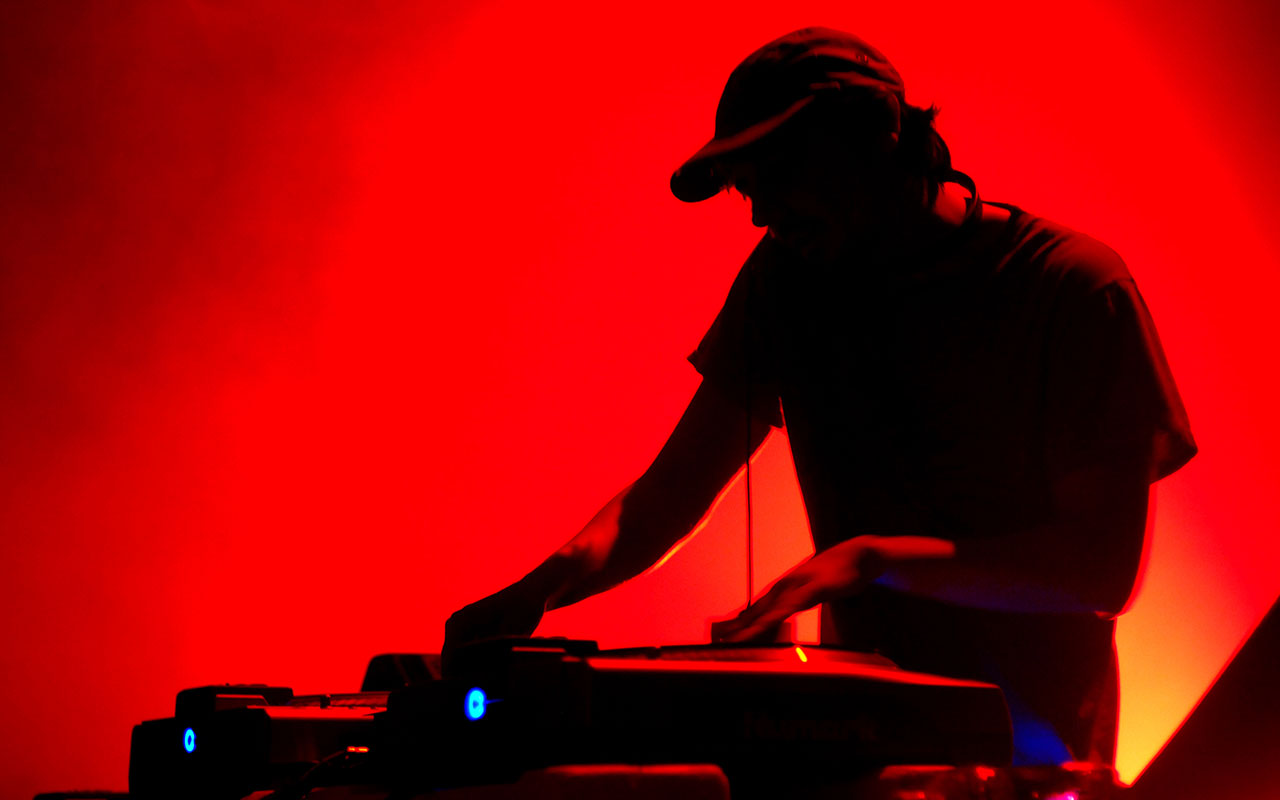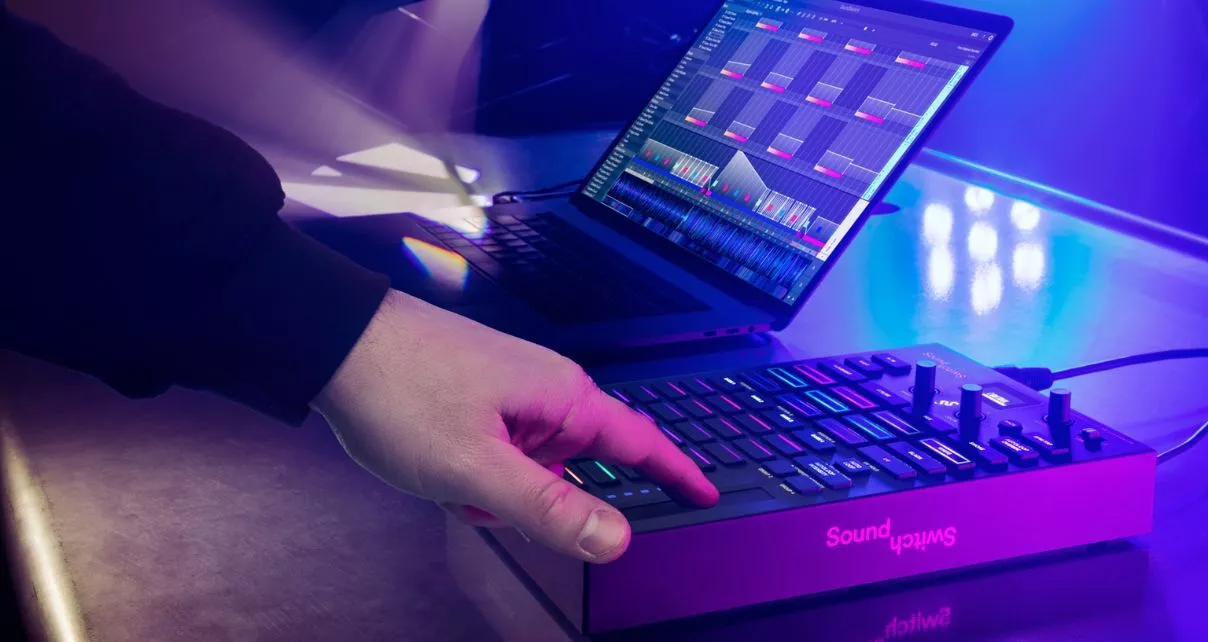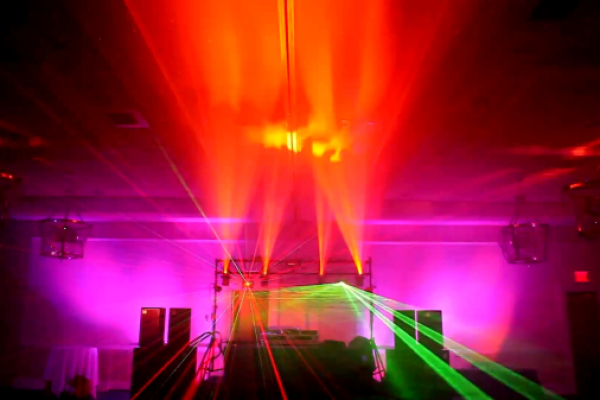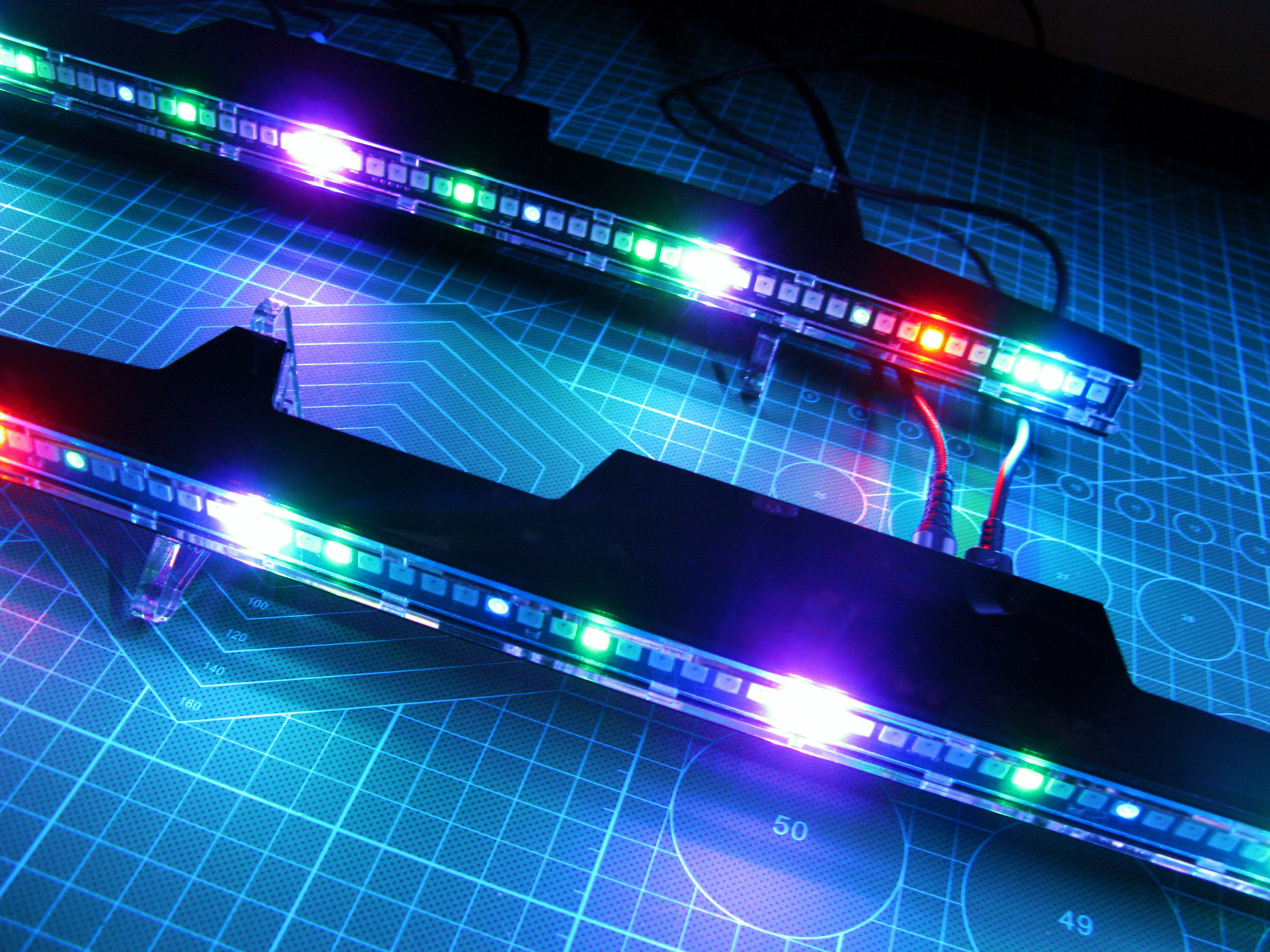Leo Ramos - Live Sunset DJ Set | Real-time Music Visualization
CLUBBEST M100 Master
Real-time Music Visualization
The next opportunity to evaluate the
quality of visualization, how much
RTMV-Technology is much more
accurately conveying the essence of
music.

The art of DJ has gained wide popularity. Today, a DJ is not just someone whose task is to mix tracks; a DJ is now a composer who creates new music. The art of DJing involves live sets where the main task is to mix tracks and arrange music, adding musical fragments and sound effects in real time. The art of DJing is about direct communication with the audience through live music.
Lighting has become an integral part of a DJ's life during sets. It is undeniable that lighting enhances the atmosphere and perception of a musical piece. Lighting can even dramatically alter the perception of the music itself. However, there is a flip side to the coin. If the lighting is not synchronized and does not correspond to the musical piece, it can have a negative effect. Therefore, the key aspect of using lighting in a musical performance is the seamless connection between the music and the lights.
Many lighting equipment manufacturers have started producing lighting controllers for mobile DJs, which allow them to control their lighting fixtures. All these controllers operate on the same principle: you need to write a sequence of commands to control your lighting devices and save this control program in advance. During the set, you can launch the visualization program for your show. To achieve maximum impact from the music visualization, it is necessary to create a separate lighting composition for each track. Audio features allow you to synchronize the lighting program with the music track in one way or another. Additionally, while operating the lighting controller, you can manually switch settings and control additional devices such as smoke machines and strobes.

But this approach has significant drawbacks:
Manufacturers of modern lighting controllers for mobile DJs mainly focus on creating compact, modern designs in a new style. These controllers typically have illuminated buttons, encoders, and a graphical display, but there are no revolutionary innovations in these consoles. The only desire of the manufacturer is to present existing visualization principles differently and package them in a new way.
I believe that DJs need lighting equipment with intelligent capabilities that can independently create music visualization in real-time. Such equipment should allow DJs to fully concentrate on the music. The key feature of such a system should be a visible connection between the visual elements and the musical composition. The ideal scenario would be when the music itself generates the light show.
I have spoken to so-called lighting technicians whose task is to create light shows for concerts, and they assure me that creating such devices is impossible and that it is a creative process beyond the reach of electronics. Talented lighting technicians are artists in their field and create stunning light shows, but even in those cases, the shows are often one-time events. Furthermore, I have never seen a "good" synchronization of light and music, which is sometimes disappointing. Most often, such light shows consist of a combination of various lighting effects, running lights, strobes, all mixed together in the hope that somewhere, somehow, it will align with the music and look good.

For a DJ who uses live music in their work, using a pre-programmed composition approach is impractical, and hiring a lighting engineer is simply unrealistic. That's why we often see that the lighting used in DJ performances has little to do with the music.
Humanity has long noticed that music has the ability to evoke visual imagery in the human mind, and that's why light shows have become an integral part of any music concert or performance.
I have dedicated all my free time to a hobby that involves developing real-time music visualization systems. Initially, I built many devices based on existing schematics and created output optical devices within my financial means. But the result of these efforts always led to the same outcome: the newly constructed device would initially bring excitement with its variety of effects, but after a few days, it would no longer bring joy, and within a few weeks, interest in it would simply fade away. This effect is known as visual fatigue, which is due to the human brain visually memorizing a lot of information and requiring constant refreshing.
From my own experience, I concluded that the existing approach to building automatic devices that can visualize music in real time does not correspond to reality. New rules, theories, and technological principles are needed to offer a fresh perspective on music visualization. According to these principles, it would be possible to create devices capable of automatically visualizing music in real time without human intervention. Moreover, I want to emphasize that such devices should have algorithms that allow for the creation of visual arrangements for melodies, which would generate new visualizations each time the same musical composition is played, eliminating the effect of visual fatigue.
I am not a musician; I simply love listening to music, but I am a fan of music visualization. That's why I embarked on a path where I defined the fundamental principles that music visualization represents to me. I named these principles "Real-Time Music Visualization Technology" or, in short, RTMV-technology.
Basic principles
Based on these principles, I began developing algorithms and designing controllers. When designing such devices, the format of the digital data required for music visualization is determined by the light sources used in the light show. The most accessible light sources for me were LEDs. With the advent of LEDs with built-in drivers, they became the primary means of visualization. This does not mean that RTMV-technology cannot be used with modern stage devices. It means that it requires a description of additional control functions for a specific lighting fixture or group, and nothing more.
Initially, for music visualization, I intended to use a 2D screen, and the development of RTMV-technology was focused on this type of screen. When the development process reached a certain level, it was necessary to create a working prototype to showcase the idea for objective feedback. Obtaining feedback is an important step as it allows you to look at the results of your work in a new way and go beyond your subjective understanding of reality. However, it turned out that creating a prototype for the 2D version required significant financial resources that I could not allocate from my income. Without demonstrating a working device, finding an interested sponsor or lighting equipment manufacturer seemed impossible.
I decided to deviate from the chosen direction and create a series of music visualization devices, similar to sound level indicators (VU meters), in order to earn the necessary startup capital. However, none of the solutions I created satisfied me. I tried adding more lighting effects, but it always ended up with the same nagging issue of visual fatigue. In other words, after a certain period of time, the device would become boring, uninteresting, and unappealing. This contradicted the goal of my work. That's when I decided to apply a simplified version of RTMV-technology for a linear-type display. A linear display involves arranging uniform light sources in a straight line, and this variant became known as 1D visualization. The initial results of testing pleased me greatly. You see, at the beginning of developing RTMV-technology, I rejected the concept of 1D visualization, believing that it would not be able to create sufficiently effective light patterns. However, as the experiment showed, it is possible and can be achieved at a sufficiently high level of efficiency.
This project was named CLUBBEST. Prototypes of two types of visualizers, models M68 and M100, were developed and manufactured. They differ in the type and quantity of LEDs used, as well as the approach to the data visualization mechanism. The primary purpose of these models was for personal, home use. Personally, I intended these projects as decorative devices for listening to music on one's PC. However, the feedback showed that this visualization approach also interested music professionals. To popularize the concept, I started recording videos demonstrating the devices' real-time operation, aiming to gather more information about the perception of this new form of art. And I began receiving positive feedback. The most inspiring feedback for me was when a subscriber of my YouTube channel wrote, "I felt like I saw the music." Yes, that's the truth - I am developing this technology so that people can see music.
Take note of how well-known lighting equipment manufacturers approach showcasing new technologies or visualization systems. They advertise and create promotional videos in an interesting way. In their videos, they provide extensive and sometimes even tedious descriptions of the new device, its unique features and capabilities, the number of new connectors, beautiful buttons, convenient encoders, and now, even OLED displays. They talk about how many lighting control sequences can be programmed into this new device, without mentioning the additional hours of work required. And most of the time, there are no real video demonstrations of the device's operation with lighting fixtures, or at best, a maximum of 10 seconds of demonstration. Why is that? It's because there's simply nothing worth watching beyond 10 seconds, as not much novelty has been developed for such devices. And for some reason, everyone remains silent about the fact that using this approach to visualization leads to the well-known effect of visual fatigue.
I believe that for a DJ, especially a mobile DJ, it is important to know how convenient, efficient, and user-friendly the newly acquired equipment will be. They need to consider how the use of this equipment will simplify their lives with lighting fixtures and not distract them from their primary focus on music. Moreover, this new device should aid them in their musical creativity. A DJ, after creating a musical composition, should be able to immediately see its visualization in real time. Unfortunately, the modern technologies offered by contemporary brands do not allow them to do so.
To evaluate the performance of the new visualization technology and demonstrate its objectivity, I create promotional videos by recording the entire musical composition. Please note that I don't edit the videos to include only specific moments. I aim to provide information about the real-time operation of the music visualization mechanism, showing the visualization results throughout the entire musical composition and highlighting the connection between light and music. Even in live broadcasts, I try to show a 5-10 minute segment of video to assess how effective a DJ's performance would be if accompanied by visualization. I record visualizations with different musical styles to demonstrate how the technology handles different types of music. Music is meant to be heard, while visualization is meant to be seen. The visualization should be of such quality that it gives the impression that the sound is coming not only from the speakers but also from the light itself.
CLUBBEST is built on the principle of "Plug and Play." You only need to feed the audio signal, and RTMV-technology takes care of everything else. CLUBBEST does not have a single adjustment knob. It automatically identifies the musical style and generates visual effects synchronized with the music on the available output optical device. In the CLUBBEST project, everything is simplified, with the light sources having consistent characteristics and a fixed quantity. Therefore, the algorithm is simplified and designed specifically for this configuration of the output optical device.
It's important to note that CLUBBEST is a highly simplified version of RTMV-technology, but the prototypes already developed can serve as a foundation for creating a range of serial products for mobile DJs and individual consumers to enhance their music listening experiences.
Furthermore, these systems that utilize real-time music visualization have a wide range of applications in clubs, cafes, bars, and restaurants where music is played and the venue owner wants to add dynamic lighting to attract visitors' attention.

Approaching the use of RTMV-technology for controlling stage lighting fixtures, the resulting lighting console would have one main feature that distinguishes it from modern consoles: it won't have a tedious programming mechanism for lighting control sequences. RTMV-technology is about music itself creating the light visualization.
The initial configuration of such a lighting console may involve visually describing the lighting fixtures to be used and their spatial arrangement. Currently, RTMV-technology allows for 1D and 2D arrangements of lighting fixtures in space. Theoretically, a 3D variant is also possible, but I have not yet defined those requirements for myself.
For a user (DJ), how would the connection of lighting fixtures look? You simply need to select the type of symmetry used in the visualization, specify the type (brand, model) of the light sources, and indicate their spatial positions according to certain rules. That's all for the setup. For more advanced users, there will be additional options for customization, such as limiting the rotation angle or maximum brightness of the light source, and similar parameters.
The preliminary configuration for RTMV-technology is necessary for the system to understand which control parameters need to be generated for managing the connected lighting fixtures. After that, the user simply connects to the audio source, and the light show begins.
Modern music visualization technology involves the process of pre-creating and programming a light composition for music, taking into account the lighting fixtures used. I believe this is a separate direction intended for lighting artists and represents a distinct form of art with its right to exist and develop.
However, it's time for a new form of art - the art of algorithms and electronics. This kind of music visualization art envisions a scenario where composers, while creating their musical compositions, also determine the accompanying light show and the visual representation of their musical works. But to achieve that, they need entirely different music visualization tools.
Now is the time to develop and create so-called intelligent real-time music visualization tools. Here's one opinion that recognizes my point, providing further confirmation that the time has come:
After watching the previous video, click here to see how RTMV-technology works, and you will fully agree with me - The time has come!
Catcatcat Electronics, Dnipro, Ukraine, 2023
Real-time music visualization technology - allows you to create completely autonomous intelligent electronic devices that can create a visual arrangement of a piece of music in real time. For this technology, there is no need for preliminary creation of a light composition, the technology is focused on automatic processing in real time.
Style visualization example #hamidshax #deephouse #housemusic. The visualization technology is completely autonomous, the user only needs to give a sound signal to the visualizer and enjoy real-time visualization.
I believe that such autonomous systems can effectively work in such streams.
I think the visualization of the stream takes it to a whole new level, it greatly enhances the perception of the musical work.
Hey everyone from Ukraine!
I am not a musician and I do not have a special musical education, I am an embedded systems engineer. But my hobby is developing real-time music visualization technology. When listening to a piece of music, I decided for myself that I wanted to have a device that, with minimal settings (or without any settings at all) for me, could create a light show. I, as a consumer, want to just come after work, turn on the music, sit on the sofa and relax, listen to music and enjoy light visualization.
I talked a lot with show business specialists who create light shows, and they convince me that such tools cannot be created. But you yourself understand that for me, as a consumer, it makes no sense to buy a lighting console, so that later I can sit and program some kind of lighting composition on a music track I like.
It is necessary for me that the visualization device, on its own, no matter how many times I listen to a music track, so many times create a new light show for me and which would not bother me.
Believe me, I designed a lot of different visualization tools, and they did not suit me at all, I came to understand that the problem lies in the lack of a theory on the basis of which it was possible to create such tools. Then for myself, on my primitive principles of understanding music, I created for myself such a theory. When constructing visualizers, I analyzed the result and made adjustments to my understanding of the connection between light and music.
The technology itself, I call RTMV-technology. Initially, RTMV-technology was developed as a 2D visualization option. But to create a full-fledged 2D prototype, today, for me, it turned out to be quite expensive to manufacture. Therefore, an attempt was made to a simplified version - 1D visualization. The idea was to get a relatively inexpensive instrument that you can simply connect an audio signal to and enjoy the light images while listening to music.
This project was called CLUBBEST and was originally focused on club music, but as time has shown, it is suitable for visualizing any piece of music. Of course, there are many limitations associated with the use of inexpensive components and the use of an MCU with low performance, but even in this case, I received and continue to receive positive feedback. For me, the most inspiring feedback is when I read in the comment: “I saw the music.” Yes, I created this technology in order to see music. And I get such feedback all the time, as the technology development process progresses.
The technology allows the creation of fully autonomous intelligent electronic devices that can create a visual arrangement of a piece of music in real time. For this technology, there is no need for preliminary creation of a light composition, the technology is focused on automatic processing in real time.
My opinion is that this technology can be used to create lighting consoles with a completely different approach to light shows, or by adding a control core to modern consoles, in a real way, take them to a new level.
For me, first of all, the task was to make the connection between music and light visible, so that the viewer of the light show caught himself thinking that the sound does not come from the sound speakers, but the sound is created by the light itself.
To popularize this technology, I began to record video clips when I connect the visualization to an existing piece of music and show how the visualization corresponds to the music stream for evaluation. Please note that I am showing a visualization of the entire piece of music, I am not editing a video, I am not showing a ripped out some good moment, I am showing how the technology works in real time, with all its shortcomings associated with the technical and financial limitations that I encountered.
I must say right away that the prototypes of the devices were made two years ago, but the opportunity to show their work appeared only now.
I suggest watching demo videos and would like feedback from the community on how interested you are in this approach.
I think the most difficult option for computer processing is the processing of classical and instrumental music, here is an example of how technology copes with the processing of an instrumental composition.
In this video, an example for comparing a visualization written on a modern console by a person and a visualization created by RTMV technology in real time, in the same 3 minutes, while the composition is being broadcast.
An example of visualization of a musical Pop composition.
More demo videos can be seen in the podcast https://www.youtube.com/playlist?list=PLOZmwe3zikuEjKRgyJdcH6FsxC2ABKJyJ here you can see the prototypes of two systems - CLUBBEST M68 and CLUBBEST M100 in action.
Initially, I made CLUBBEST as a tool for my PC to listen to music. But as it turned out, it can be successfully applied to the workplace of a composer, musician, DJ, and also used as a decorative decoration for the interior of clubs, cafes, restaurants, where, as I believe, this technology can be successfully used when broadcasting music.
I love watching DJ streams , and I think that for DJs who focus on creating live music in their work, they simply need such tools. The musician should focus on the music, and the visualization system should help decorate his work with visualization and the creation of meaningful visual images.
I believe that at the current level of development, it is already possible to create a commercial instrument, in the form of an LED bar, for DJs, so that it can be used for live performances by musicians. Such an instrument can be placed in front of the DJ console or behind the DJ - to the left and right of it. I believe that light interpretation enhances the perception of a piece of music several times over.

The peculiarity of the idea itself is to give the musician the opportunity to focus on the music in a live performance, and give the visualization to electronics.
Now in the prototypes , the terminal optical device has a linear arrangement of the same type of light sources. To work with lighting fixtures that are used on stage, you need a configurator and, of course, a completely different approach to generating control data.
I am now trying with my idea to interest lighting equipment manufacturers in the development of this technology and the creation of new tools that will allow us to take a different look at the light SHOW.
But now, as I said, I'm interested to hear your opinion on how interesting this light visualization is, and how closely it expresses the theme of the musical work. I, in the latest videos on my channel, tried to collect different styles so that I could evaluate the possibility of the algorithms.
If you have any questions, feel free to ask questions, I am ready to provide more technical information to understand the very idea of such a visualization.
I will be grateful for your feedback.
Deep Tone Rebel (Michael Dietze) @ Südgarten Leipzig
LINK: Südgarten Leipzig
30 Years on Decks 2 by Deep Tone Rebel (Michael Dietze)
LINK: 30 Years on Decks 2
Hello everyone
My specialty is mixing with at least 2 Turntables. U read right, Turntables! And of course real pressed vinyl!
Style: Groovy Techhouse with a touch of Techno!
Listen in: https://soundcloud.com/mute-radio/capture-de-nuit-2-markus-haze
http://www.mixcloud.com/markus-haze/live-vinyl-mix-minimal-trilogy-coupole-bielbienne/
https://soundcloud.com/markus-haze-1/minimal-techhouse-invasion-pt1
https://soundcloud.com/markus-haze/markus-haze-minimal-techhouse-invasion-part-2-11-12-2010
Still motivated for some dates 2023 so, if you're lookin' for a little dj show at your event, contact me on facebook, phone or via mail:
Ref.
Coupole/Chessu (BE)
Planet e (BE})
OHM10 (BE )
Kapitel (BE)
Cargo Club (BE)
Para/Gold Club (NE)
Die Cafete (BE)
A-Klub (hungary)
Mokka (Thun)
Club Schlaflos (AG)
And many more.
https://www.facebook.com/djmarkushaze
https://www.facebook.com/saveth3vinyl
Booking: [email protected]